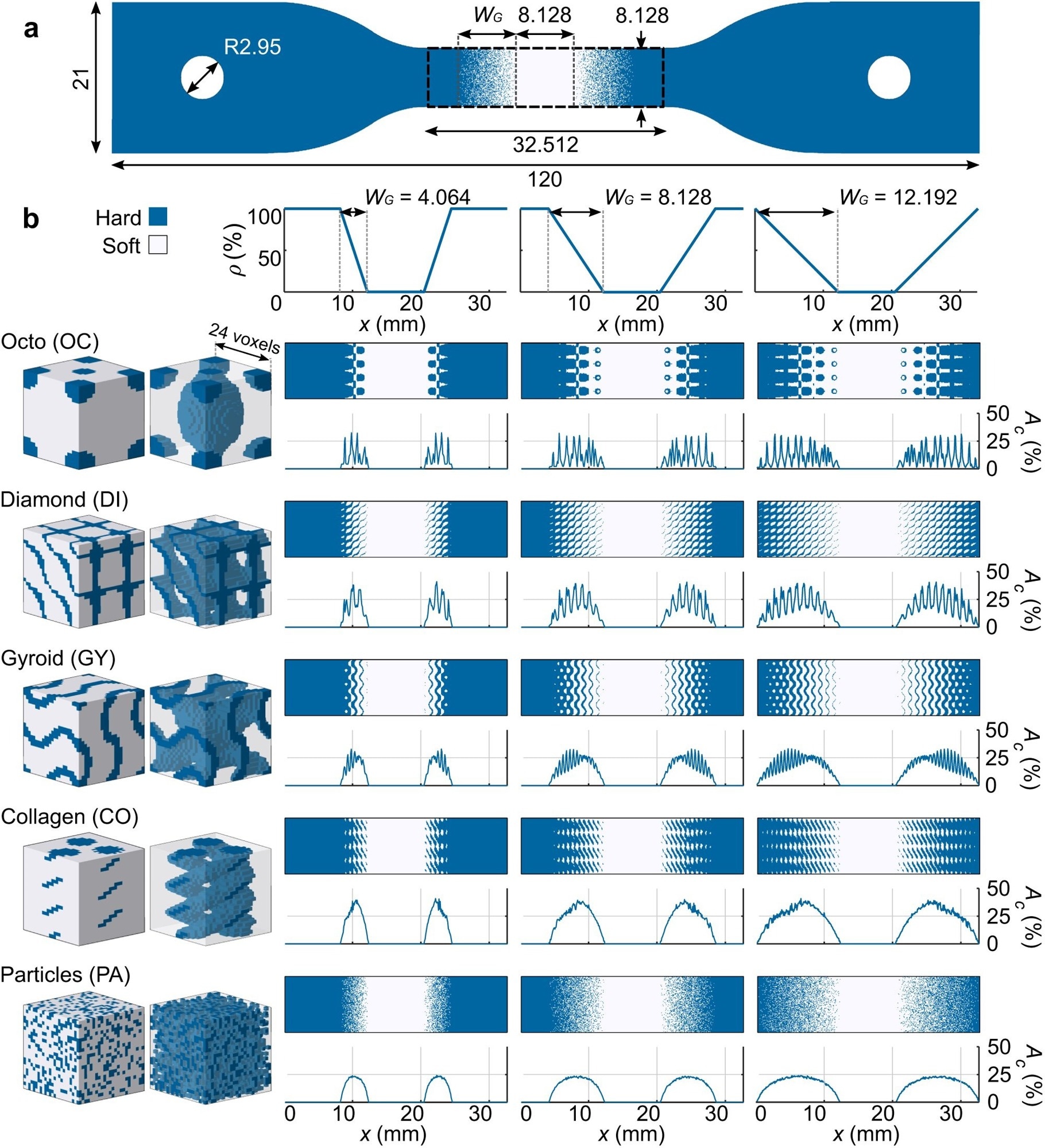Leveraging an innovative 3D printing process, scientists at TU Delft have developed hybrid multi-material interfaces that closely mimic nature's design of bone-tendon connections. Their research, recently published in Nature Communications, opens up numerous potential applications.

The soft–hard interface designs tested under tensile conditions. a The standard tensile test specimens furnished with a functional gradient connecting the hard and soft polymer phases through linear functions of hard phase volume fraction (p) (out-of-plane thickness = 4 mm). b All the initial designs with different functional gradient widths (WG) and their calculated percentage of the soft–hard normal contact area (Ac). We combined three different values of the gradient length (WG) with five different unit cell geometries (i.e., Octo, Diamonds, Gyroids, collagen-like helices, and randomly distributed particles). Credit: Nature Communications (2023). DOI: 10.1038/s41467-023-43422-9
Despite the substantial disparity in hardness between bones and tendons, their intersections in the human body remain resilient. Inspired by this bone-tendon connection, a team of researchers from the faculty of Mechanical, Maritime, and Material Engineering (3mE) embarked on a journey to optimize the interfaces between hard and soft materials in man-made structures.
Design Inspiration
Amir Zadpoor, Professor of Biomaterials and Tissue Biomechanics, elucidates that a mismatch between two interconnected materials leads to stress concentration.
This phenomenon directs mechanical stress to the connection point, often culminating in the failure of the softer material. Nature, in contrast, exhibits a gradual change in properties at interfaces, a characteristic observed in various instances.
A hard material doesn't suddenly become a soft material. It changes gradually, and that smoothes out the stress concentration.
Amir Zadpoor, Professor, Biomaterials and Tissue Biomechanics, Delft University of Technology
Taking this into consideration, the researchers employed various geometries and a multi-material 3D printing technique to enhance the contact area between hard and soft interfaces, mirroring the design found in nature.
Another factor in the design process is recognizing that the force a soft material can withstand before failure is typically lower than that of a hard material.
It's only relevant to make the interface as strong as the soft material because if it's stronger, the soft material will fail anyway and that's your theoretical limit.
Dr. Mauricio Cruz Saldivar, Study First Author, Delft University of Technology
The researchers successfully increased the toughness values of interfaces by 50% compared to a control group, pushing towards the theoretical limit—an essential achievement highlighted by the team. Moreover, the study established a set of design guidelines applicable across various scenarios to enhance the mechanical performance of bioinspired soft-hard interfaces.
A Whole Product in One Go
Notably, the technique developed by the team allows for creating an entire product in one go. This is a significant advancement, considering that products with multiple materials typically rely on adhesives for attachment, while some parts may be assembled or mechanically connected, as seen in applications such as automotive or aerospace.
But what we are trying to do is remove the extra steps that are involved, and have everything in one go. That makes it possible for us to combine even more exotic materials together, for example, materials that have more damping resistance versus materials that are stronger.
Zjenja Doubrovski, Assistant Professor, Delft University of Technology
This blend allows for a broader range of applications.
Future Applications
This technology opens up numerous possibilities. Potential applications span medical devices, soft robotics, and flexible devices. Additionally, the team is keen on investigating the creation of interfaces with living cells, facilitating procedures such as connecting implants to the surrounding soft tissue.
“Eventually, we would like to regenerate bone and the connection between the bone and the muscle. That would mean integrating living cells into this interface, which would add multiple layers of complexity to the construct,” says Assistant Professor Mohammad J. Mirzaali.
In the end, the outcomes of this research pave the way for a myriad of potential future investigations.
Optimisation of hard-soft material interfaces: A 3D printed imitation of bone-tendon connections
Video Credit: Delft University of Technology
Journal Reference:
Saldívar, M. C., et al. (2023) Bioinspired rational design of bi-material 3D printed soft-hard interfaces. Nature Communications. doi.org/10.1038/s41467-023-43422-9.